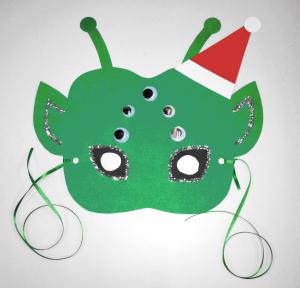Do you want to help your space cadets get into the Math Blaster holiday spirit?
It can be challenging to pair science and math fun with the excitement of this festive season. You can spend some time with your Blasters talking about space, science, and math as you make this Holiday Alien Mask craft.
Materials you will need:
- Colored construction paper
- Scissors
- Glue
- Hole puncher
- Glitter, stickers, decorations, etc.
- Ribbon, string, etc.
Directions:
- Using the colored construction paper, cut out a shape that your child feels looks most like an alien. Encourage them to use their imagination.
- Cut out eyes at the bottom half of this shape. Also, cut out ears and antennas to put on mask.
- Punch holes in the sides of the mask so that you will be able to string it through with ribbon.
- Decorate the mask with glitter and stickers. You can design the front of the mask in your own creative styles.
- After, use the ribbon or string and tie through the holes in the mask. Use this to secure the mask on your child’s head.

Help your kids dress up in a festive, other-worldly way that will make this a holiday to remember. Tell us what you think about this craft, and let us know how your kids liked it!
Filed under: Crafts, Parents and Kids, Uncategorized | Tagged: Alien Mask, Holiday, Holiday Craft, Kids' Craft | 1 Comment »







